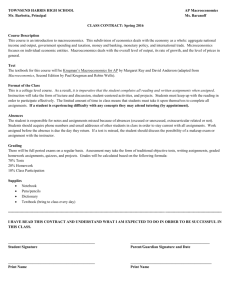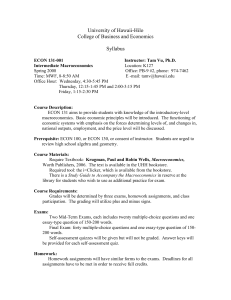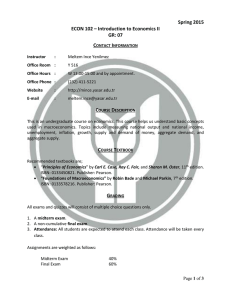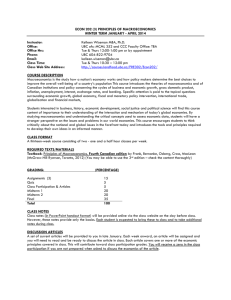econ-311-02-lu - California State University Channel Islands
advertisement
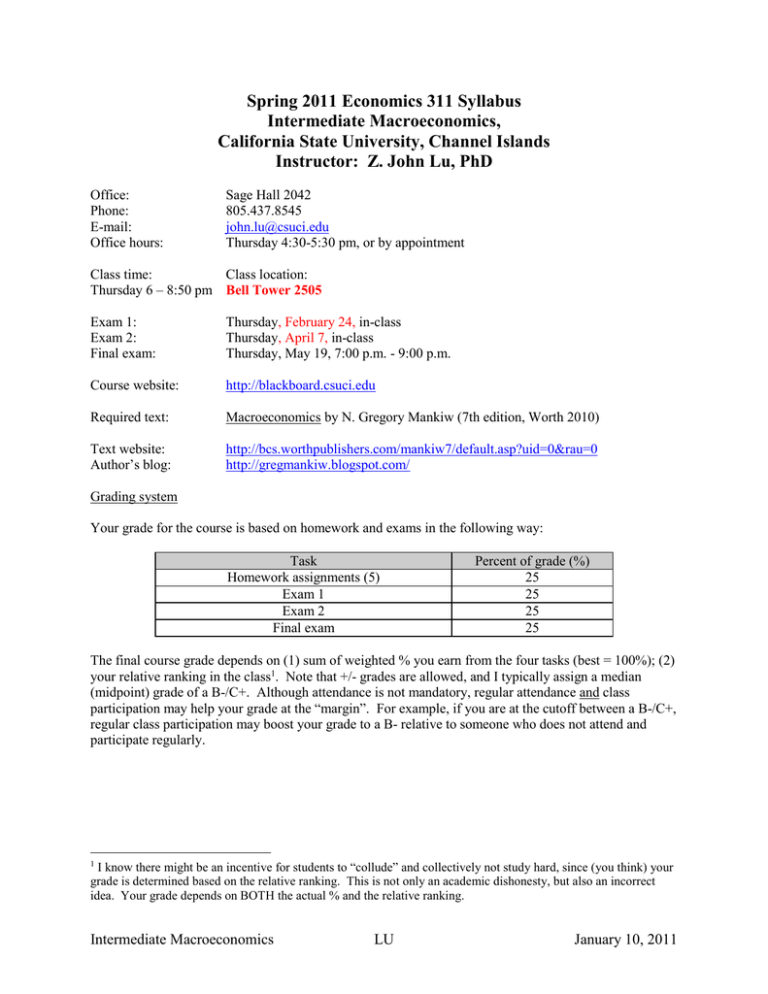
Spring 2011 Economics 311 Syllabus Intermediate Macroeconomics, California State University, Channel Islands Instructor: Z. John Lu, PhD Office: Phone: E-mail: Office hours: Sage Hall 2042 805.437.8545 john.lu@csuci.edu Thursday 4:30-5:30 pm, or by appointment Class time: Class location: Thursday 6 – 8:50 pm Bell Tower 2505 Exam 1: Exam 2: Final exam: Thursday, February 24, in-class Thursday, April 7, in-class Thursday, May 19, 7:00 p.m. - 9:00 p.m. Course website: http://blackboard.csuci.edu Required text: Macroeconomics by N. Gregory Mankiw (7th edition, Worth 2010) Text website: Author’s blog: http://bcs.worthpublishers.com/mankiw7/default.asp?uid=0&rau=0 http://gregmankiw.blogspot.com/ Grading system Your grade for the course is based on homework and exams in the following way: Task Homework assignments (5) Exam 1 Exam 2 Final exam Percent of grade (%) 25 25 25 25 The final course grade depends on (1) sum of weighted % you earn from the four tasks (best = 100%); (2) your relative ranking in the class1. Note that +/- grades are allowed, and I typically assign a median (midpoint) grade of a B-/C+. Although attendance is not mandatory, regular attendance and class participation may help your grade at the “margin”. For example, if you are at the cutoff between a B-/C+, regular class participation may boost your grade to a B- relative to someone who does not attend and participate regularly. I know there might be an incentive for students to “collude” and collectively not study hard, since (you think) your grade is determined based on the relative ranking. This is not only an academic dishonesty, but also an incorrect idea. Your grade depends on BOTH the actual % and the relative ranking. 1 Intermediate Macroeconomics LU January 10, 2011 Exams There will be NO make-up exams. If you cannot attend one or more of the scheduled exams, you will be at risk for receiving a poor to failing final grade, even if you ace the other components of the grade. While the exams are not cumulative, the learning in this course is sequential and cumulative. In other words, one cannot learn effectively the materials covered in the 2nd half of the course if one does not learn well the materials covered in the 1st half; the 1st half is the pre-requisite for the 2nd. It will be a big mistake to think one can procrastinate learning until 2nd half of the course and still receive a decent grade. All exams contain multiple choice questions, T/F matching, and short essay questions. The exact distribution may vary between exams, but generally short essay questions do not constitute more than 1/3 of the total points in an exam. The questions will be focused on the lecture notes, textbook and homework (also taken from the textbook). The final exam will concentrate on materials after the 2nd midterm exam. The short essay problems require that you write concisely and coherently, and be able to manipulate simple algebraic equations. Homework assignments There will be a total of five (5) homework sets in this course. They are due 1 – 2 weeks after assigned. Most homework assignments cover multiple chapters. Please turn in your assignments at class time or at my office or in the Digital Drop Box under the Course Tools link prior to class time on the due date. Late homework will not be accepted. If you cannot finish in time, hand in what you have completed for partial credit. If you know that you will be out of town or otherwise unavailable when the assignment is due, you must submit it early. I highly recommend that you turn in the hardcopy for homework, instead of relying on the Drop Box. If you must submit it electronically, please make sure your file is PC compatible—if I cannot open it with my CSUCI office PC, then the assignment will be considered “not turned in”. You are encouraged to work in groups to complete the homework assignments. However each student must submit his/her own answers to each problem set. Homework assignments are graded based on accuracy, completeness and effort; quality of exposition and professionalism of presentation may count for as much as 25% of your score. For this reason, I strongly encourage you to submit the homework typed. Answers to the homework problems will be posted on the website after the due date under the Course Documents folder. You are expected to read the answers to the homework assignments by yourself, since I will not generally cover homework assignments in lecture. When I do cover certain assignments, I may call on individuals to explain their answers in class from time to time. Class attendance and participation Regular class attendance is expected. It may help your grade if you are otherwise on the borderline between 2 grades. Intermediate Macroeconomics LU January 10, 2011 Course overview Macroeconomics is a branch of economics that deals with the aggregate performance, structure, and behavior of a national or regional economy. Macroeconomists develop theories, models, and other measurement tools to examine, explain, and predict the complex relationship between “macro-” variables including gross national product, consumption and saving, investment and debt financing, unemployment and inflation, international trade, and factors driving short-run fluctuations in business activities and long-run economic growth. Understanding these macroeconomic tools is fundamental in evaluating policy alternatives, developing robust forecasting capabilities (in both private and government sectors), and becoming an informed citizen in the society. Our class time will include lecture and in-class discussion (including some current events). Lecture material will be based on the material from the textbook, so it is good to read the text before or shortly after class. Learning objectives: At the end of this course, good students will be able • • • • • • To understand measures of national income, unemployment, and inflation, and their relationship To understand the role of money and monetary policy in the economy To understand the role of public sector and fiscal policy in the economy To understand the factors of economic growth in the long-run To understand the basic macro-economic models and Business Cycle Theory (e.g., Cobb-Douglas production function, IS-LM model, Phillips Curve, and quantity theory of money, etc.) To understand how government debt affects the economy Cheating Don't cheat. If I catch you looking at someone else's exam or at notes during an exam, you will receive an F for the exam. Any case of cheating will be referred to Judicial Affairs. Working with fellow students on homework assignments, however, is not cheating and is encouraged. Advice on studying Create your own notebook: print the lecture notes before lecture and write on them during lecture. It is highly recommended that you read the assigned material before it is covered in class. Remember that my lecture notes are NO substitutes for your reading the textbook materials. Learning the materials in a measured pace is far better and less anxiety-producing than cramming before exams. Complete the homework assignments carefully and on time. Follow domestic and international economic affairs closely, as they may be the best real world examples and case studies to apply the knowledge you learn from the textbook. Pay attention to what political figures and pundits say about the economy and their policy recommendations, and see how the theories and models you learn in class may support or refute their positions. Discuss or debate policy issues with your classmates. You may find this course will be more enjoyable and you will probably learn more. Recommended Readings outside Textbook (select one) Wall Street Journal Los Angeles Times New York Times The Economist (weekly magazine on international political economy Intermediate Macroeconomics LU January 10, 2011 Topics and Estimated Timelines Date 01/27/11 02/03/11 02/10/11 Lecture topic Review of syllabus; Introduction to Macroeconomics Measures of real and nominal income and expenditure; Intro. to inflation and unemployment Market for Goods and Services; Market for Loanable Funds 02/17/11 Unemployment: a detailed look 02/24/11 Exam 1 (1 hour); Inflation: a detailed look 03/03/11 Inflation: a detailed look (II); Banking System in the US; Demand and Supply for Money Economic growth: Theory 03/10/11 03/17/11 03/24/11 03/31/11 Economic growth: Empirics and Policy Exam 2 (1 hour); Introduction to aggregate demand and supply 04/07/11 Aggregate demand 04/14/11 Aggregate demand 04/21/11 04/28/11 Aggregate demand Macroeconomic Stabilization Policies: are they effective? 05/05/11 Does government debt matter? 05/12/11 05/19/11 Assigned reading Syllabus; Chapter 1: The science of macroeconomics. Chapter 2: The data of macroeconomics Notes (HW, Exams) Chapter 3: National income: where it comes from and where it goes. Introduction: p.45-47; Sections 3-3 to 3-5 Chapter 6: Unemployment Do Problems 7,8,9,11, and 12 (page 77-78) Exam 1 covers Chapters 1-3 and 6 Chapter 4: Money and Inflation Chapter 4: Money and Inflation; Chapter 19: Money supply, demand, and the Banking system Chapter 7: Economic Growth I: Capital Accumulation and Population Growth Chapter 8: Economic Growth II: Technology, Empirics, and Policy (minus Section 8-4) Spring Break Exam 2 covers Chapters 4, 7, 8, and 19; Chapter 9: Introduction to economic fluctuations Chapter 10: Aggregate demand I Chapter 10/11: Aggregate demand II Chapter 11: Aggregate demand II Chapter 15: Stabilization Policy Do Problems 4,6, and 7 (page 41-42) HW #1 due: (Chap. 2 + 3) Do Problems TBD Do problems TBD Do problems TBD HW#2 due: (Chap. 4+6+19) Do Problems TBD Do Problems TBD Do problems TBD HW#3 due: (Chap. 7+8+9) Do problems TBD Do problems TBD Do problems TBD HW#4 due: (Chap. 10+11) Do Problems TBD Chap 16: Government Debt and Budget Deficits Do Problems TBD Global Economy: Flow of Chap 5: The Open Economy HW#5 due: (Chap. goods/capital between countries (time permitting) 15+16) Final exam: 7 – 9 pm Covers Chapters 9 – 11, 15, 16 and 5 (time permitting) Intermediate Macroeconomics LU January 10, 2011


